

LUSH RETREAT
Teeming with exotic plants flaunting bold foliage, this Coral Gables, Florida, garden reveals itself a little at a time
photographs by ROGER FOLEY
styling by HEATHER CHADDUCK HILLEGAS

No tropical garden would be complete without a refreshing pool. Coconut palms form an arching canopy and shade the pool. EDITOR’S TIP: When landscaping around a pool, choose plants that won’t drop foliage or flowers into the water.
Nice weather, blue skies, rich culture, and tree-lined streets that seem right out of a movie set attract visitors to South Florida year after year. Dana and Quentin Nason are lucky enough to live there full time. They were drawn to the area for its semitropical climate, proximity to relatives, and all that nearby Miami has to offer. Once they settled on an “Old Spanish” style house, characterized by its clay tile roof, stucco facade, and other Mediterranean features, they set about carving out their own piece of paradise. “Our wish list included an oasis-like pool; lots of color; great views from all over; spaces for privacy; and a lush, tropical feel,” says Dana.
To help with their vision, the Nasons enlisted the Palm Beach landscape architecture firm of Sanchez & Maddux. The resulting garden is a peaceful, verdant space where the surrounding neighborhood seems to fade away once you walk through the gates.
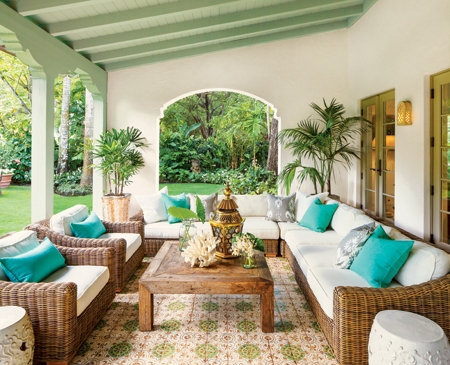
Each arch of the loggia frames a different slice of the garden. Comfortable furniture eases the transition from indoors to out.

A lawn separates the house from the pool and runs right up to the water’s edge. EDITOR’S TIP: For a pretty pool border, think beyond the typical concrete surround, and try grass. It’s cool underfoot and gives the pool a more natural look.

The view from an upstairs window reveals a private sitting area that’s sequestered from the outside world. A gate topped with urns provides access from the front yard. Geometric beds in front impose some formality from the street side.
GARDEN STYLE
Tropical
KNOWN FOR Exotic plants, bold foliage, colorful flowers
SIGNATURE PLANTS Palm trees, ferns, elephant’s ears, bromeliads, orchids, heliconia, angel’s trumpets, and others that enjoy mild winters and high humidity
AT HOME Contemporary, Mediterranean, bungalow, or around swimming pools
GARDENER PROFILE Perfect for the gardener who wants a resort feel at home
Notice the Details

The coral stone path curves, in order not to reveal the entire garden all at once. The way that you see the property in stages is intentional, adding a sense of anticipation.

Peace lily
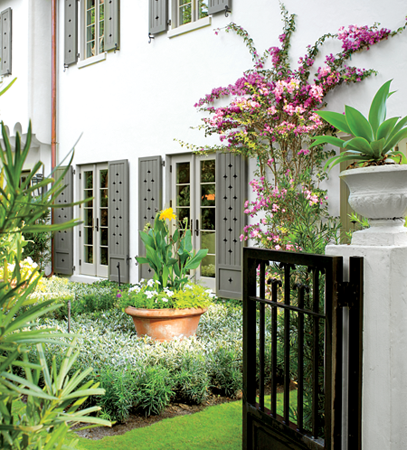
A purple bougainvillea vine softens the front of the house. Symmetrical parterre beds add a formal touch.
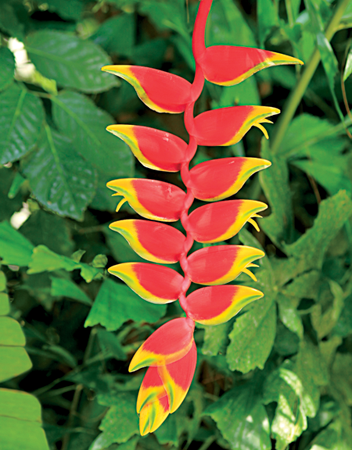
Heliconia
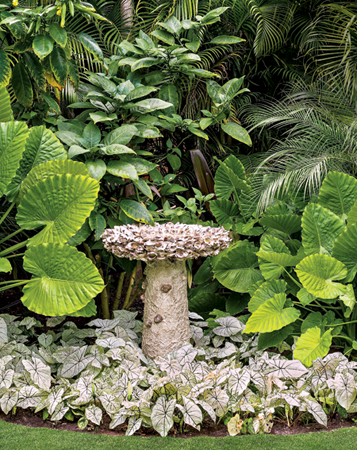
A shell-encrusted birdbath serves as a focal point amid a bed of caladiums.
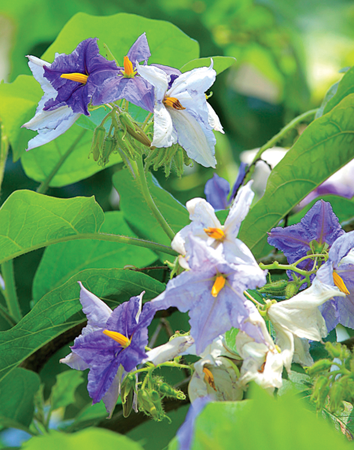
Brazilian potato tree
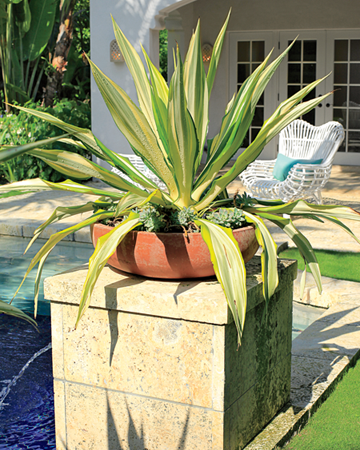
Variegated false agave

Even the driveway gets special treatment. Coquina stone laid in a decorative pattern is interplanted with Zoysia grass, reducing the heat and glare that a long expanse of concrete would produce in the Florida sun.
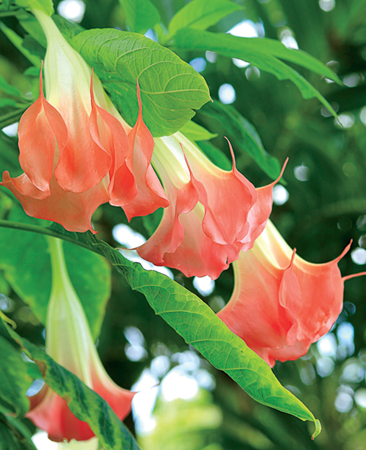
Angel’s trumpet
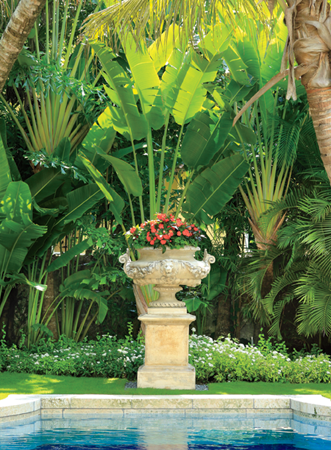
GROW GUIDE
Bring in the Tropics
Even if you aren’t lucky enough to live in a tropical climate, you can still get the look. Plant these in pots, and bring them indoors to protect them on chilly nights.
PEACE LILY
BROMELIAD
HELICONIA
PALMS
NORFOLK PINE

ENGLISH ACCENT
Modest in size but huge in appeal, cottage gardens evoke feelings of intimacy and enclosure. Some plants are grown for sheer splendor. Others are treasured for the warm memories
photographs by ROGER FOLEY
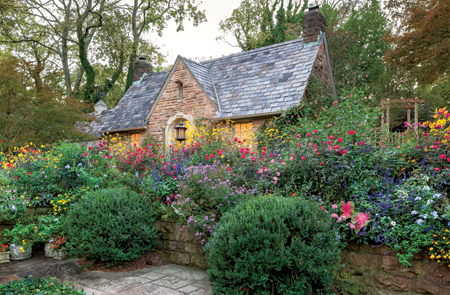
Two American boxwoods and a stone retaining wall add order to the riotous blooms of yellow swamp sunflower, purple ‘Indigo Spires’ sage, ‘Double Knock Out’ roses, and lavender ‘Senorita Rosalita’ cleome. EDITOR’S TIP: Structure is important when planning a cottage garden; it provides form and context amid the chaos of blooms.
Why plant a cottage garden? The simple answer is this: For many people, it’s the easiest garden to tackle. Take it from Cathy Adams. She freely admits that she was not born with a trowel in her hand. Planting a flat of impatiens each spring was once the extent of her horticultural prowess. But in 1997, she and her husband, Tom, fell hard when they saw this vine-covered Tudor home overlooking Birmingham. It’s a good thing that love conquers all, as “every invasive plant in the state of Alabama called these once-formal gardens home,” she declares. As Cathy cleared brush by the truckloads, magic began to happen. Old perennials appeared where the sun warmed the bare soil. “I fell in love with the legacy left by the women who had gardened here before me.”
Cathy loved the idea of a cottage garden full of vivid colors, and with the help of Jason Powell, owner of Petals From the Past in Jemison, Alabama, she created a garden (shown here in fall) that overflows with flowers and attracts butterflies. Even though the plantings may look complicated, her go-to picks are easy-care roses, heat-tolerant sages, and showy swamp sunflowers.
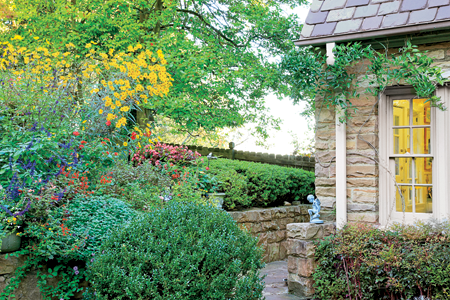
Azaleas won’t overstep their bounds atop a retaining wall, keeping the path clear beside the house.
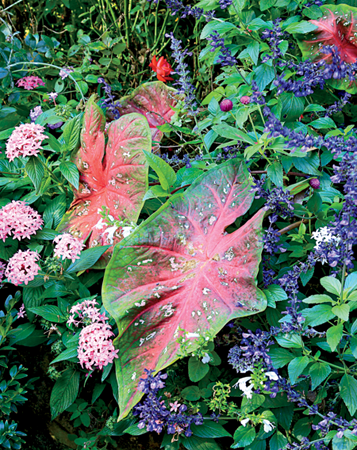
Pink pentas, caladiums, and ‘Indigo Spires’ sage mingle for a pleasing mix of color and form.
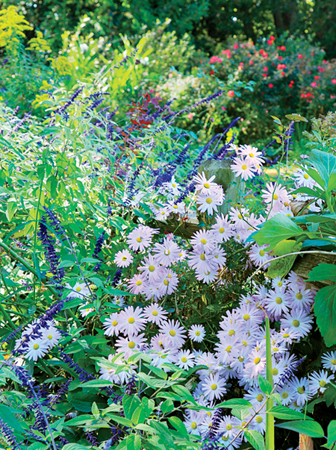
Old-fashioned mums are a cottage garden favorite, reappearing year after year.
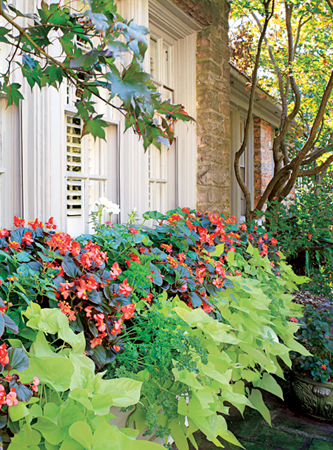
Window boxes add loads of personality but can mean a lot of upkeep. EDITOR’S TIP: Choose carefree plants, such as begonias, lantanas, sweet potato vine, and geraniums, for a full look with little effort.
GARDEN STYLE
Cottage
KNOWN FOR Freeform shapes, beds overflowing with dozens of plants, seedlings sprouting in pathways, and vines clambering over fences and trellises
SIGNATURE PLANTS Rambling roses, climbing vines, sweeping perennials, reseeding annuals
AT HOME Bungalows, country homes
GARDENER PROFILE Perfect for the gardener who likes to express individual style and isn’t concerned with keeping strict order
THE MORE THICKLY YOU PLANT, THE LESS ROOM THERE IS FOR WEEDS TO SPROUT, SO YOU DON’T SPEND EVERY WEEKEND ON MAINTENANCE.

Surrounded by blooms, a stone terrace feels like a secret garden and is a serene spot for watching butterflies.
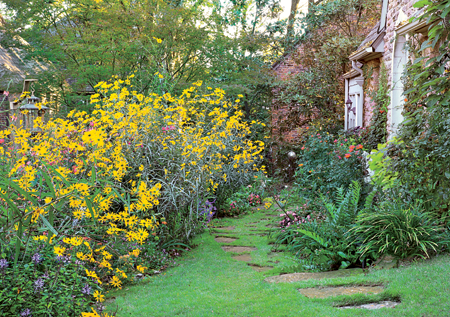
A winding stone path invites you for a stroll through the flowers. EDITOR’S TIP: Cut back tired, leggy annuals and perennials in July, and you’ll be rewarded with a fresh flush of flowers in September.
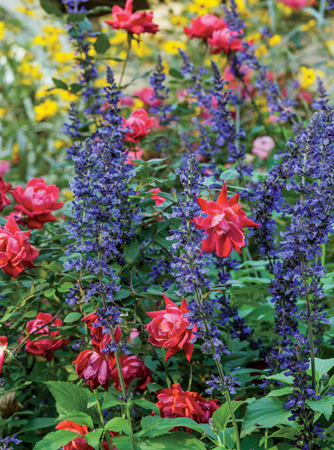
Pops of bright red ‘Double Knock Out’ roses provide a vibrant contrast to deep purple ‘Indigo Spires’ sage.
GROW GUIDE
Butterfly Favorites
PORTERWEED
‘DOUBLE KNOCK OUT’
ROSE
‘INDIGO SPIRES’ SAGE
LANTANA
BUTTERFLY BUSH
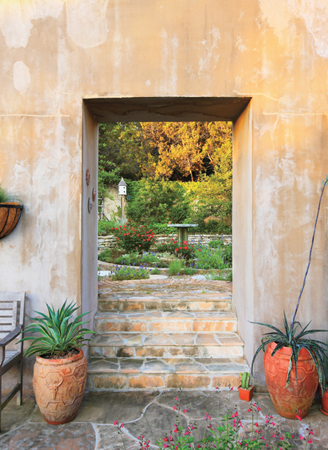
Adobe walls frame the view into the English garden. Bluebonnets, poppies, and ruby grass sprout in the gravel around a birdbath ringed with ‘Knock Out’ roses.

OASIS OF BLOOMS
Even with the most challenging of climates, flowers can flourish with smart choices and a gardener who lets the plants do their thing—without a lot of fuss
photographs by RALPH LEE ANDERSON

It never crossed Jenny Stocker’s mind that she wouldn’t be able to grow flowers in the Texas heat. Raised on the Northwest coast of England, Jenny has been surrounded by lush gardens her whole life. When she and her husband, David, moved to the Texas Hill Country, she set about turning their rugged, gravelly lot into an English-style garden with outdoor rooms overflowing with flowers. But she had to adjust for the brutal Texas heat, where summer temperatures reach into the 100s and you can collect rainfall in a thimble.
The smart choice was to look to native Texas wildflowers that self seed in just a few inches of gravel. First came the Texas bluebonnets. Jenny gathered seeds from plants at the back of the lot. Now they are so happy, she has to yank them out by the hundreds. Also thriving are corn poppies, Dahlberg daisies, larkspurs, Gulf Coast penstemons, blanket flowers, cosmos, Hinckley’s columbines, wine cups, skullcaps, and Blackfoot daisies. All drop seeds freely and find their spots in the garden.
Drip irrigation provides most of the water in an efficient manner, and Jenny relies on yuccas, agaves, and aloes for containers because they rarely need tending.
Flowers growing in cracks tend to change patterns from year to year, and Jenny doesn’t try to control them. “Who cares if it’s a riot of mismatched colors?” she asks. “Long ago, I gave up on trying to grow plants in just one palette. Mother Nature does the best plantings. If it grows here, it gets to stay.”
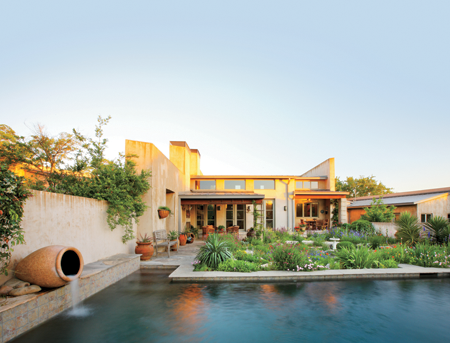
Every room of this contemporary Southwestern home opens to a walled garden that corrals plants and protects them from marauding deer and other animals. Inside the walls, Jenny tends the plants. Outside, they fend for themselves. EDITOR’S TIP: If you live in an area where deer are a problem, build a fence or wall to deny access to your tender plants.
GARDEN STYLE
Southwest
KNOWN FOR Minimal lawns and rugged plants that take the heat and drought
SIGNATURE PLANTS Wildflowers, self-seeding annuals and perennials, and drought-tolerant trees and shrubs
AT HOME Adobe, contemporary, second homes
GARDENER PROFILE Perfect for gardeners who like flowers that can fend for themselves
Bulletproof Beauties
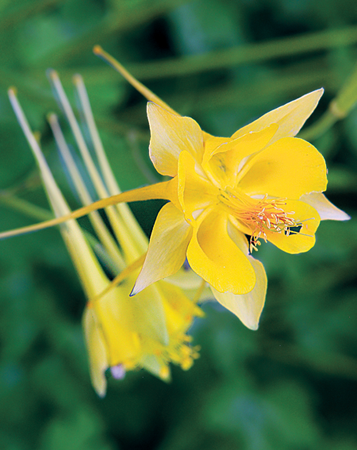
HINCKLEY’S COLUMBINE (Aquilegia chrysantha hinckleyana) self-seeding perennial up to 2 feet tall; showy spring flowers

DAKOTA VERBENA (Verbena bipinnatifida) self-seeding perennial; up to 1 foot tall
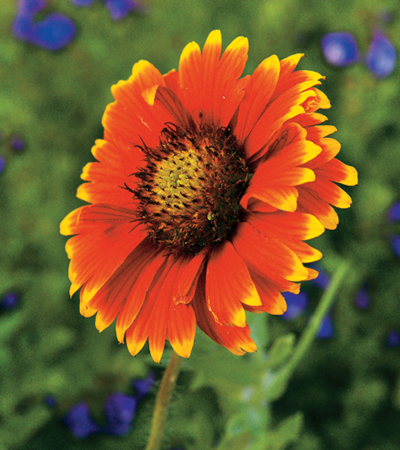
BLANKET FLOWER (Gaillardia aristata) self-seeding perennial; up to 1 foot tall

CORN (OR SHIRLEY) POPPY (Papaver rhoeas) self-seeding annual; up to 3 feet tall
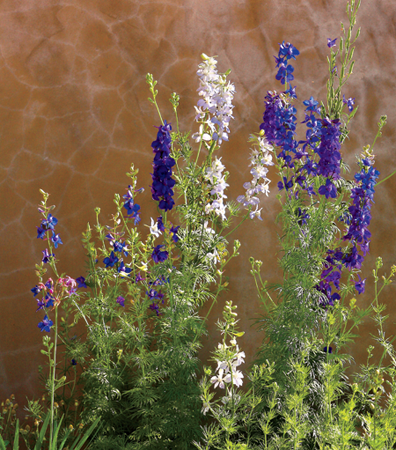
LARKSPUR (Consolida ajacis) self-seeding annual; up to 5 feet tall
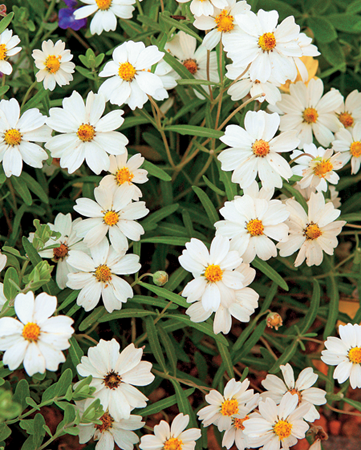
BLACKFOOT DAISY (Melampodium leucanthum) self-seeding perennial; 1 foot tall
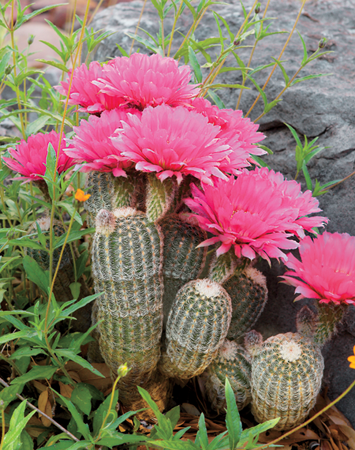
CREAM LACE CACTUS (Echinocereus reichenbachii) 8 inches tall; hardy to Zone 8
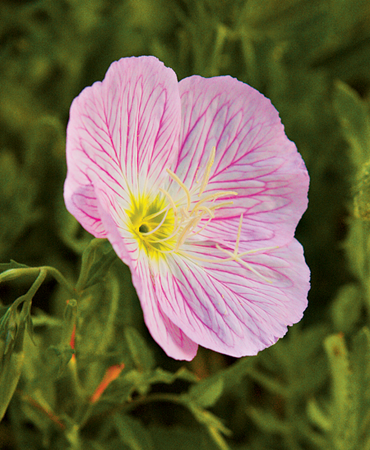
SHOWY PRIMROSE (Oenothera speciosa) self-seeding perennial; 1 foot tall
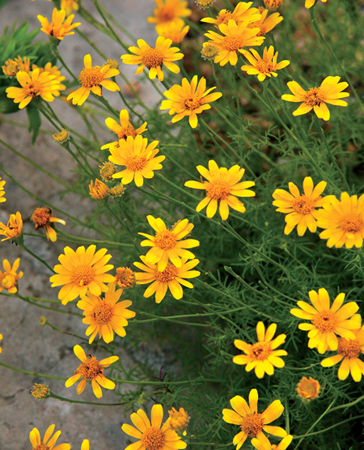
DAHLBERG DAISY (Thymophylla tenuiloba) herbaceous perennial; up to 10 inches tall

Larkspurs, poppies, penstemons, and salvias bloom in the cracks between limestone slabs in the sunken garden. EDITOR’S TIP: Don’t fret over plants that overstep their bounds. Either pull them out and add them to your compost pile, or let them amble where they like.

FLOWERS ON HIGH
A dedicated gardener finds the perfect patch of land on which to plant the garden of her dreams
photographs by RALPH LEE ANDERSON
styling by BUFFY HARGETT MILLER
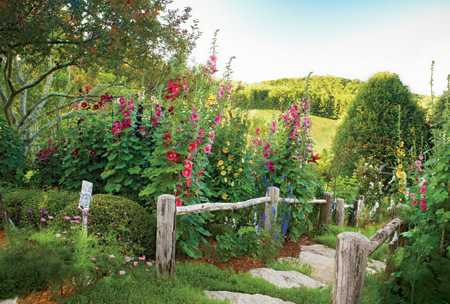
Larkspurs and hollyhocks rise beside the steps and frame the view of a Christmas tree farm in the distance. A simple fence defines the space. EDITOR’S TIP: An open fence serves as a handrail for the path and marks where to cut plants back.
You might think that the only things that flourish in rugged terrain are moonshiners and mountain men. That may be so, but in western North Carolina, at 3,850 feet above sea level, the holy trinity of garden conditions—long sunny days, cool nights, and good drainage—comes together to form a mighty elixir.
Plants grow bigger, faster, and bushier here than they ever would below. That’s what drew Becky Savitz and her husband, Ed, to the mountains. The couple lives in Tampa for most of the year, but their friend Marty Hirons convinced them to buy a summer home in North Carolina. “You have no idea what real gardening is till you come up here,” she insisted.
Becky had always craved flowers like lilacs, peonies, lavender, hollyhocks, foxgloves, and spring bulbs that would wither in the Florida sun, so the idea of a vacation place where she could get her flower fix was appealing.
Their little piece of paradise started with a plan to enclose the garden. It consists of distinct areas linked by stone steps and pathways. Fences, walls, gates, shrub borders, and even espaliered pear trees define each space. The first area they planted is affectionately known as the Wedding Garden because their daughter, Sallie, was married there. After all, owning a summer place is about making memories.
But Becky doesn’t pack up her trowels at summer’s end. Each winter in her Tampa home, she sows seeds ordered from catalogs and ones brought back from North Carolina. Around the second week of May, after the last spring frost flees the mountains, she fills a trailer with pots of seedlings and sets off for her summer paradise.
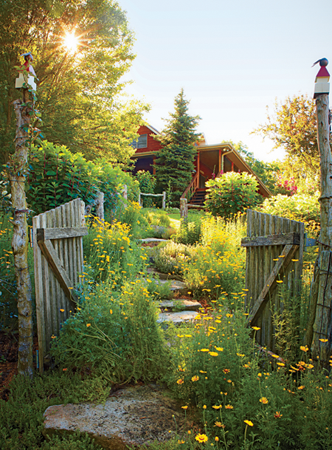
An open gate reveals stone steps leading up to the house. Golden marguerites (Anthemis tinctoria) adorn each side with sunshine. EDITOR’S TIP: Soften the look of a path with clump-forming perennials that do double-duty as cut flowers.
GARDEN STYLE
Mountain
KNOWN FOR Relaxed, colorful plantings and the use of natural materials, such as unpainted wood and local stone
SIGNATURE PLANTS Hollyhocks, rambling roses, mountain laurel, herbs, perennials
AT HOME Country homes, rustic modern homes, cabins
GARDENER PROFILE Perfect for the gardener who likes a relaxed look that still has structure
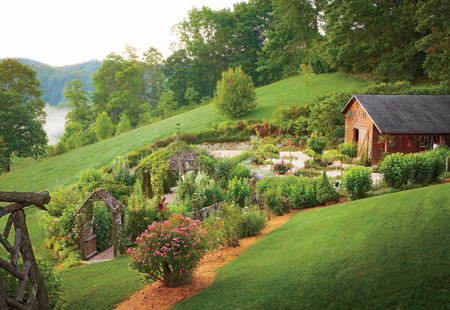
Enclosing the garden with structures, fences, and walls gives each space a purpose. A twig arbor announces the entry, and a path winds its way to each area.
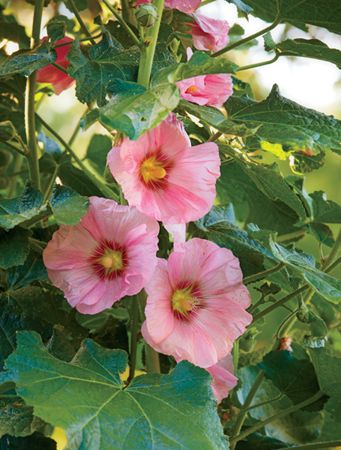
Hollyhocks star in several spots around the garden.
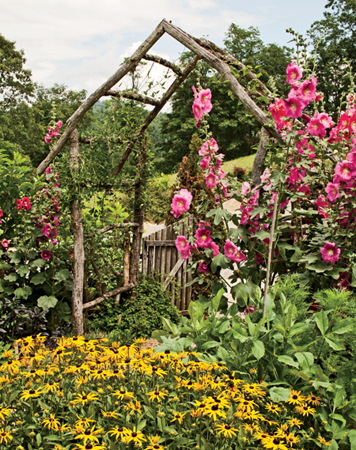
A blanket of black-eyed Susans brings a layer of color to the base of a rustic arbor.
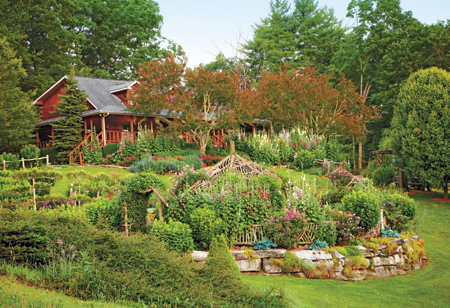
The Wedding Garden was leveled with a stacked-stone wall on the low end. Rockery plants soften the look.
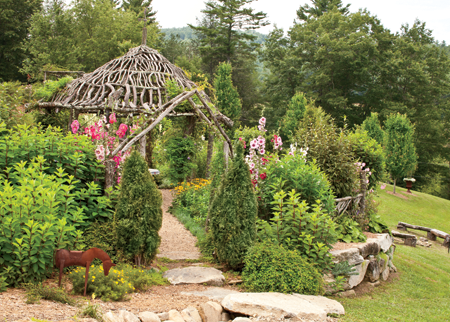
A gazebo, made with mountain laurel and black locust branches, forms the centerpiece of the garden. Black-eyed Susans, hollyhocks, and hydrangeas lend color. EDITOR’S TIP: Craft garden structures from materials found on the property for a truly indigenous look.
LONG SUNNY DAYS AND COOL NIGHTS MAKE FOR THE PERFECT CONDITIONS.

GROW GUIDE
Outrageous Hollyhocks
Hollyhocks get tall—Becky’s tower more than 10 feet high—so be sure to plant them in the back of a border. They are short-lived perennials, meaning that each plant lives but a few years. They compensate for this by dropping lots of seeds. New seedlings more than make up for any older plants that die.
SOIL Plant in fertile, moist, well-drained soil. Sow seeds in late summer for next year’s blooms, or plant seedlings in the spring.
SUN Grow in full sun or partial shade in the hottest climates.
SECRETS Flower spikes may need staking as they grow. To keep blooms coming all summer long, promptly remove all spikes that have faded flowers.

GREEN REVIVAL
Bringing a historic Charlottesville, Virginia, plantation garden back to life meant editing the plants and letting evergreens take center stage
photographs by ROGER FOLEY

The symmetrical plan for this garden room features an English urn fountain that’s centered as a focal point between the new porch and arbor. The plantings provide a sense of intimacy and are low-maintenance, so the homeowner can truly enjoy the garden.
When Camille Price first toured Tudor Grove plantation, an antebellum home set on 18 acres in the Virginia countryside, she was beguiled by a 100-yard-long American boxwood allée. The dense evergreen tunnel led to an overgrown walled garden complete with a storybook stone shed. “I was in awe that something so old had survived with its structure intact,” she says. Smitten with the idea of saving this treasure, Camille bought the place in August; by spring, she was deep into the landscape’s revival.
Because the best-looking gardens take into account the style of the house, the Georgian architecture of Tudor Grove meant that the garden would need to have a formal feel. Rather than create new layers with flower borders, Camille worked to emphasize what was already there. She discovered the beauty of the structures, vistas, and fountains, framed by the allée of stately boxwoods. The boxwoods were sheared to open up the 12-foot-tall tunnel for easier passage.
Besides enhancing existing plantings, Camille consulted with a local landscape architect to create a practical, all-green garden below a new porch. The original design featured lots of deciduous plants, but Camille substituted boxwoods, so she could enjoy the garden from her windows even in the snow. Beyond the parterre, a new arbor sits on the foundation of a tumbled-down cabin. It’s on axis with the boxwood parterre and lines up perfectly with the new porch, keeping the formal lines of the garden intact. The four columns are made of water-resistant cypress and sit atop reclaimed fieldstone found on the site. Blending new materials and existing elements and coaxing new life into the established plants, this garden pays homage to the past but also meets the needs of everyday living.
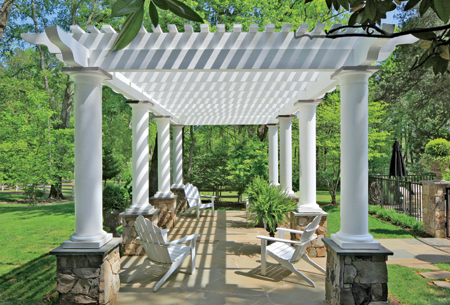
A new pergola eases the transition to the pool and uses the same stone found throughout the property.
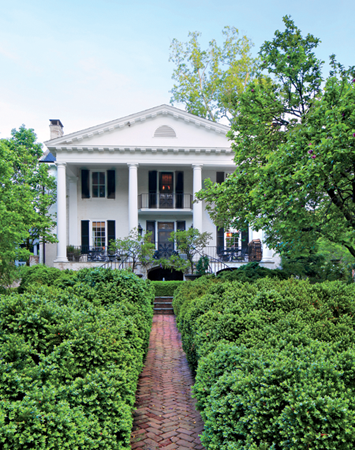
A formal brick path bisects English boxwoods leading to the front of the house.
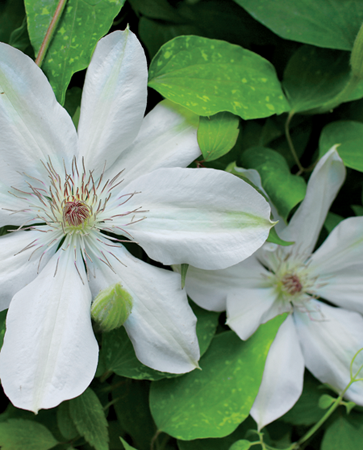
Reducing the variety of plants also reduces maintenance. Clematis blooms year after year with little care.
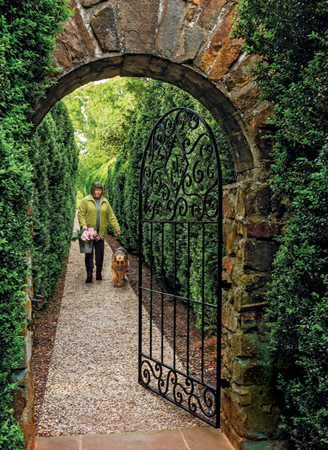
A new wrought iron gate with Tudor Grove’s initials was designed to fit an existing stone arch at the end of the allée.
GARDEN STYLE
Formal
KNOWN FOR Symmetry, strong patterns, and geometric shapes
SIGNATURE PLANTS Boxwoods and other evergreens
AT HOME Georgian, Mediterranean, French, or Victorian architecture styles
GARDENER PROFILE Perfect for the gardener who likes order and discipline
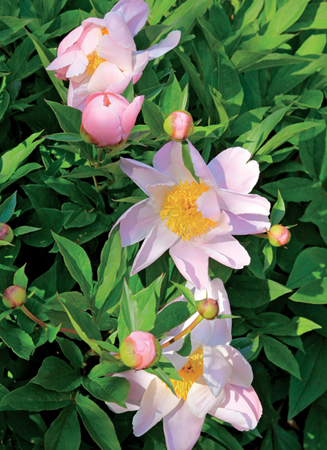
The voluptuous blooms of peonies enjoy full sun or, in hotter climates, part shade. EDITOR’S TIP: The secret to planting is not to bury them too deep. Dig a hole only 2 1/2 to 3 inches.
HARDSCAPE ELEMENTS, SUCH AS OUTBUILDINGS AND WALLS, SHAPE THE GARDEN AND DETERMINE WHERE YOU CAN PLANT. THEY FUNCTION AS THE GARDEN’S BONES, PROVIDING A BACKDROP.
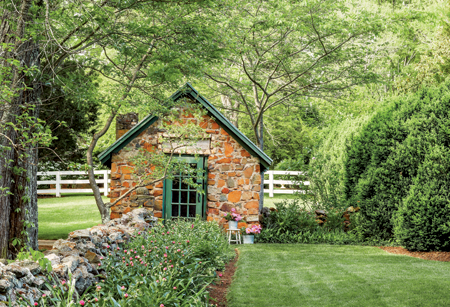
A stone shed anchors the peony garden. When Camille began to clear what looked like a meadow beside the shed, more than 100 single and double herbaceous peonies in pink and white emerged in long borders. They are deer resistant and provide the primary color for the garden.

A combination of formally inspired garden elements suits the symmetrical plan. The stained-concrete urn fountain is surrounded by a circle of bluestone and set high on its base to adjust for the slope of the lawn. Just beyond the fountain, Camille built a new arbor on the foundation of a tumbled-down outbuilding.